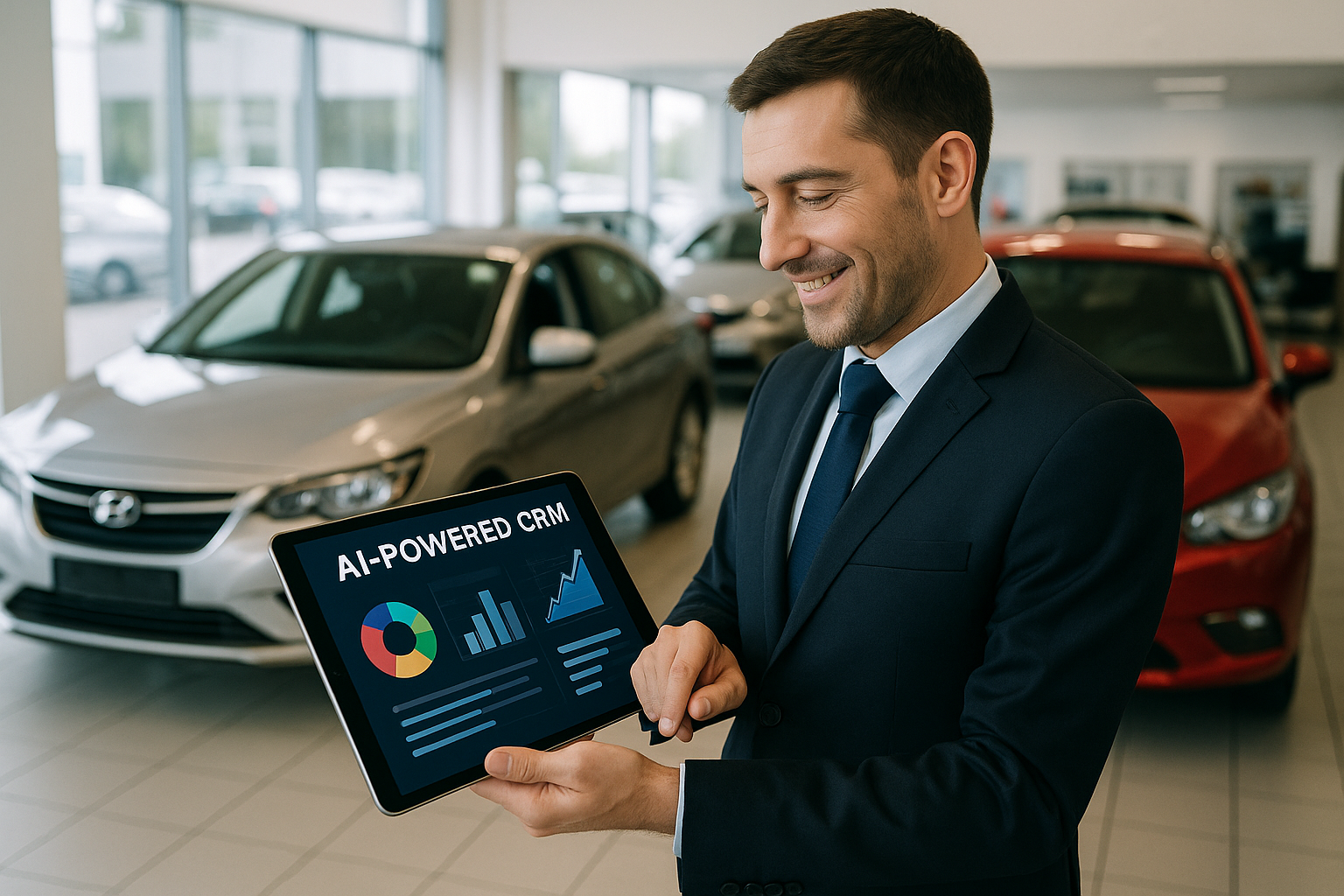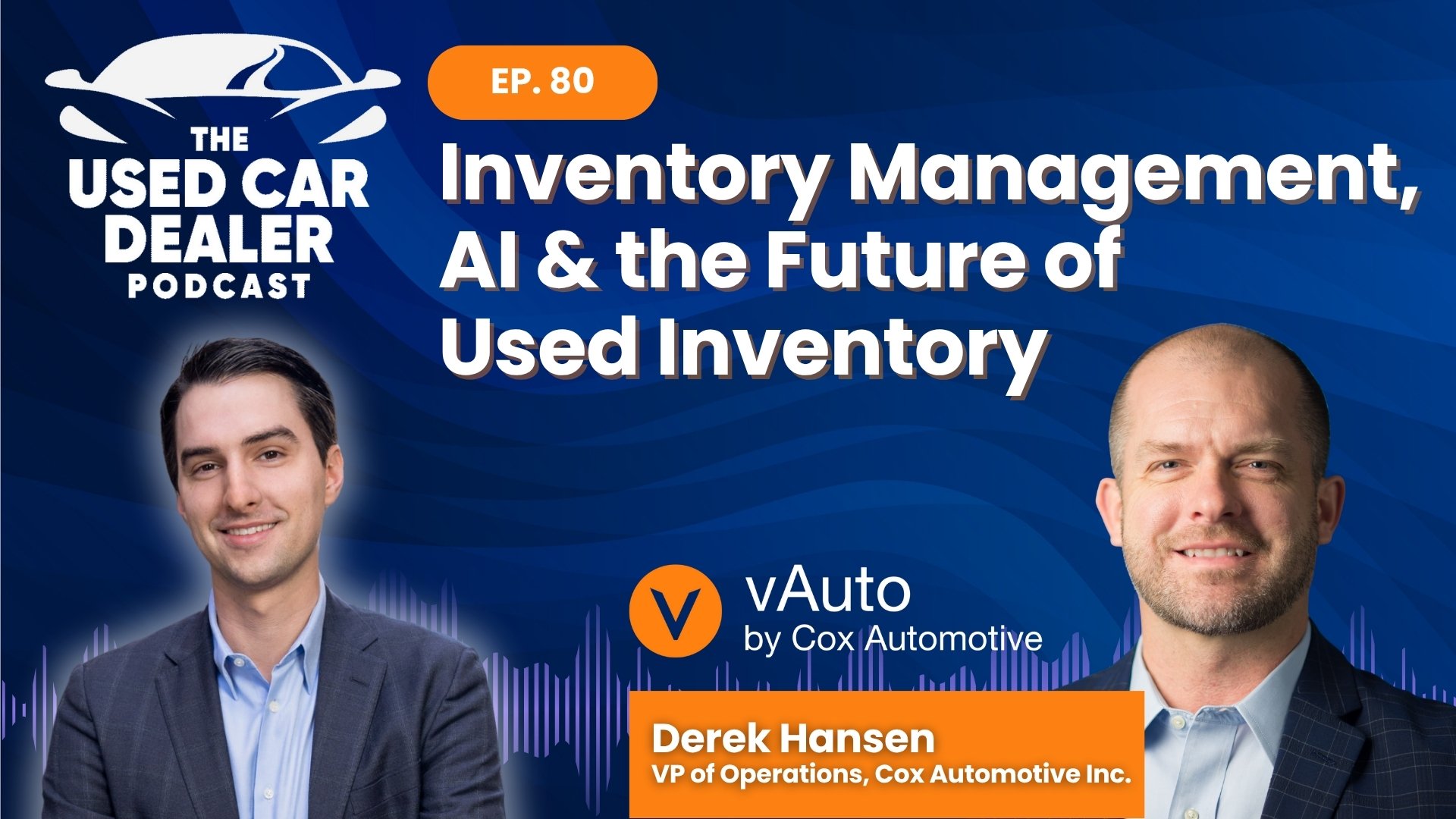In this transcribed episode of the Used Car Dealer Podcast, Zach talks with Cole Reiken, Managing Director of Blue Driver, to unpack about how smarter diagnostics and data-driven tools are reshaping dealership profitability and customer trust.
Cole shares lessons from his career at Impel.AI, Open Lane, and Canadian Black Book, and how those experiences inform his leadership at Blue Driver. He dives into the balance of serving both consumers and enterprise dealers, the challenge of system fatigue in dealerships, and why seamless workflow integration is key to adoption.
The conversation covers EV diagnostics, predictive insights, fraud protection, and how Blue Driver Max helps dealers avoid costly trade-in surprises. Cole also looks ahead at the role of data integration, battery health, and a future where diagnostics follow the vehicle through its entire lifecycle.
Whether you’re focused on reducing reconditioning risk, improving appraisal accuracy, or preparing for EV adoption, Cole’s insights offer practical takeaways for independent and franchise dealers alike.
Zach: Zach here, and I wanted to welcome Cole to the Used Car Dealer Podcast. I’m excited to have you on and, as Managing Director of Blue Driver, a leader in smarter diagnostics and data-driven tools, reshaping used car profitability and customer trust. You bring a unique perspective on how technology is transforming dealership operations. So let’s jump into the podcast.
Cole: Thanks for having me, Zach—really excited to have this chat with you.
Zach: So Cole, you’ve held roles at impel.AI, Open Lane, and Canadian Black Book before joining Blue Driver. What prompted you—or what got you interested—to join Blue Driver, and what lessons from your previous experience are really relevant to your current role?
Cole: Yeah, Zach, I think what really got me excited in joining Blue Driver was the product-market fit. My background is in product management and bringing products to market, specifically for car dealers and the auto industry, both on the retail side as well as the wholesale side. So when I was doing the analysis of looking for an opportunity, one of the things to look for is how well a product actually satisfies needs in the marketplace. And Blue Driver to me was one of those—I looked at it one time and was like, wow, this is a perfect product. It adds value, it solves a problem, it educates, and it actually will drive ROI for dealers in the commercial space, but also in the retail space—giving you a very, very good solution for our retail product, for consumers.
So that’s what got me really excited about Blue Driver: the way the product fits with solving problems and adding value for both retail and commercial users. The second part of your question is really interesting. I’ve had a unique background and a wide breadth and depth of bringing solutions to market; all of them are very different. At Impel.AI more recently—it’s an amazing company on an amazing mission with an amazing rocket ship they’re on—the combination of a product-led growth organization with the power of AI, and real AI that’s delivering transformative workflows for the dealership space, was absolutely amazing to experience firsthand. The AI there isn’t hype; we hear a lot about AI now in every corner we touch—this is real solutions making dealership lives easier and adding value.
Open Lane was very different. I was responsible at that time for ADESA.com and ADESA.ca, managing the online marketplaces and understanding the nuances of the wholesale industry—what makes an auction business run, the speed, the transparency, the trust you have to build between buyers and sellers—to allow people to make substantial financial decisions very quickly. It opened my eyes to all the parts that go into that. And Canadian Black Book was, again, very different—really eye-opening to how data, and in particular vehicle valuation data, is such a core part of the auto industry. There isn’t a part of the industry that doesn’t touch or isn’t affected by vehicle valuations one way or another—loan values, floor planning, you name it. It touches every part of it, and it’s amazing how overlooked vehicle valuations can be as that cornerstone of the entire industry. I think the common thread throughout my journey has been the intersection of technology and automotive—bringing tools that actually drive value to customers.
Zach: Very well put and an extremely interesting background. My next question is about building teams that span both hardware diagnostics—consumer tools—and enterprise-grade diagnostics like Blue Driver Max. What’s been your strategy for balancing those different customer needs?
Cole: Fabulous question. It’s something I thought a lot about before joining, and what I discovered is that the consumer and the enterprise—diagnostic capabilities with OBD2 diagnostics and the ability to provide insights into what’s happening mechanically with a vehicle—share a core. That core can be built upon for the customer experience, but it varies for consumer versus commercial. Success isn’t simply about powering a scan. For consumers, it’s about how we present the data back to them and the job they’re trying to do—most often, they’re trying to fix a car themselves. For dealers, it’s a very different experience: it’s about workflow and efficiency, ROI, speed, coverage, integrations across the dealership software ecosystem, and consistency from one rooftop to the next.
So to manage both, you build the technology to fulfill the core value proposition—provide insights into the vehicle—and then present results based on each audience’s needs. That ties into workflows and overall experience for retail consumers versus everything we build for the commercial experience. Internally, we have a team focused on the retail business—Amazon sales and top-of-funnel metrics—and for the commercial space we have an onboarding team, dedicated customer support, and a training team to tailor the experience to our client base. Each sticks to its swim lane, but we leverage the strong core technology and deliver it differently to each audience we serve.
Zach: Some of the dealers listening may know Blue Driver, some may not. Can you walk us through what Blue Driver offers today—especially the difference between consumer and the enterprise dealership product?
Cole: Absolutely. Blue Driver is our retail brand: an OBD2 diagnostic device that scans proprietary components inside the automobile to understand why a warning light is on—what DTCs (diagnostic trouble codes) might exist inside the vehicle’s systems. What we do better than anybody else is take that alphanumeric DTC and translate it to English—plain language—so people understand it. And where possible we have a proprietary database of known, verified fixes certified by mechanics. We’ll suggest: “We know how to repair this; here’s how to go about it.” For retail users, we’ll say: “Here’s the known fix and the parts you’re going to need—buy these parts.”
For the commercial space, through Blue Driver Max, we help a dealership understand that trade-in vehicle and, through the suggested repair, what parts and labor costs would be to perform that repair. So when evaluating a trade-in, a dealership sees the total cost of reconditioning from a mechanical perspective. That does three things: First, it lets dealers maximize profit by putting the right number on the car. An evaluation guide might tell you that’s a $20,000 car. However, if Blue Driver Max comes back with $2,000 of suggested reconditioning because there are these trouble codes underneath, that is no longer a $20,000 car. That’s going to be an $8,000 car. And tied to that, you prevent the “oh my God, I missed something” later—when the car moves to the back lot waiting to be reconditioned. We hear all the time: “I didn’t know it had a transmission problem or an ABS problem; I just got burned for three or four thousand dollars on the back end.” We can prevent that on the front end. Our catchphrase is: scan before it costs you.
Lastly, we provide validations to protect against fraud. People clear check-engine lights before trade-ins; we can help understand when it was cleared and how long ago. We can validate VIN and mileage—if someone is trying to rebrand a VIN or mess with mileage. And we integrate our diagnostic reports with appraisal and reconditioning systems—so if you scan up front, we protect you and speed time to frontline by passing diagnostics into tools like Repair360 and appraisal systems.
Zach: That’s awesome for dealers, and it leads to my next question. Diagnostic transparency is increasingly valued by consumers and dealers alike. In your view, what are the major headwinds preventing wider adoption at dealerships?
Cole: For me, one headwind is system fatigue. If you don’t have a product that integrates and easily fits into dealership workflows, it becomes shelfware. We spend a lot of time onboarding and coaching customers on the right way to appraise a vehicle with a scan. The number one reason people skip scanning is the perception of time. We coach: when you start the appraisal, plug in the scanner; then do your exterior/cosmetic appraisal. In a minute or two you come back and your scan report is done. It adds no time. Too many tools don’t fit dealership processes; change management is hard at the dealership level, and if you’re working against the workflow, adoption suffers.
Zach: EVs and software-defined vehicles are changing the diagnostic landscape. How is Blue Driver adapting?
Cole: EVs are a growing part of the car park, and our roadmap is very focused on EV products. We’ll bring enhancements to Blue Driver and Blue Driver Max to enable EVs—maybe via a connector using the current device, maybe a separate device. We’re spending a lot of time understanding needs. It’s a different set of data—battery health in particular. Some experts say the “right way” to assess battery health is a 30-minute drive with different speeds and cycles—that doesn’t work for trade-ins or auctions. We’re figuring out the optimal way to give guidance on battery health within real-world dealership and auction workflows.
Zach: Let’s talk future outlook and innovation. What innovations in diagnostics will make the biggest difference for dealers—in speed, accuracy, cost, or customer perception?
Cole: First, we’re fortunate to license data directly from OEMs to power what we do. That gives us comprehensive ability to scan OEM systems—breadth and depth of model coverage, years, components. I still think the integration side—making it easier on the commercial side to integrate diagnostic data across dealership systems—will be huge. Kicking off recon faster, knowing in advance what work is needed, and shrinking the time from trade-in to frontline ready.
Second, using our data to provide predictive insights beyond the scan you perform right now. We see year/make/model/mileage across environments and regions. If a 2016 Toyota Camry, for example, comes back clean, but we know from other factors that certain issues are likely in the next 90 days or 2,000 miles, we can surface those. I can see a future where you put a number on a vehicle considering a valuation guide, the scan, and five other likely factors over the next 90–180 days—impacting valuation based on what’s likely to happen.
Zach: And your vision for how diagnostic tools will be used by consumers versus dealers in five years?
Cole: Consumers are keeping cars longer—the average age is exceeding 12.5 years. Older cars mean more repairs. Bridging the knowledge gap with clear, plain-English diagnostics helps consumers understand severity—what to do now versus later—and makes conversations with repair facilities easier. On the commercial side, more information will follow the vehicle. We’ll better understand history and repairs, and consolidate data into a single vehicle record across the lifecycle—sale, ownership, recon, disposal—leading to more accurate values and insights.
Zach: Rapid fire. What product or feature has surprised you most in development over the past year?
Cole: Not a single feature, but a workflow insight: as soon as dealers learn to scan during the appraisal—no added time—the lightbulb goes off and adoption skyrockets.
Zach: One app you use every day?
Cole: Google News—I’m a news junkie.
Zach: One thing in the auto industry that’s overhyped right now?
Cole: Software with weak ROI, especially “AI everywhere” claims that don’t integrate into dealership workflows—those become shelfware.
Zach: I’ve really enjoyed having you on the podcast. Any exciting updates, events, or news from your company in the next quarter or year that the audience should know?
Cole: We’re constantly evolving. Our roadmap is aggressive, quarter by quarter. We’ll be at Used Car Week, SEMA, and NADA with Blue Driver Max—and we’ll have net-new features releasing in parallel with those events. Come find us, or schedule a demo, and we’ll walk you through what’s new.
Zach: Super exciting, Cole. Thanks again for joining me on the podcast.
Cole: Thanks for having me, Zach—this has been fun.





.jpg)
.jpg)
.jpg)
.jpg)


.jpg)
.png)
.png)
